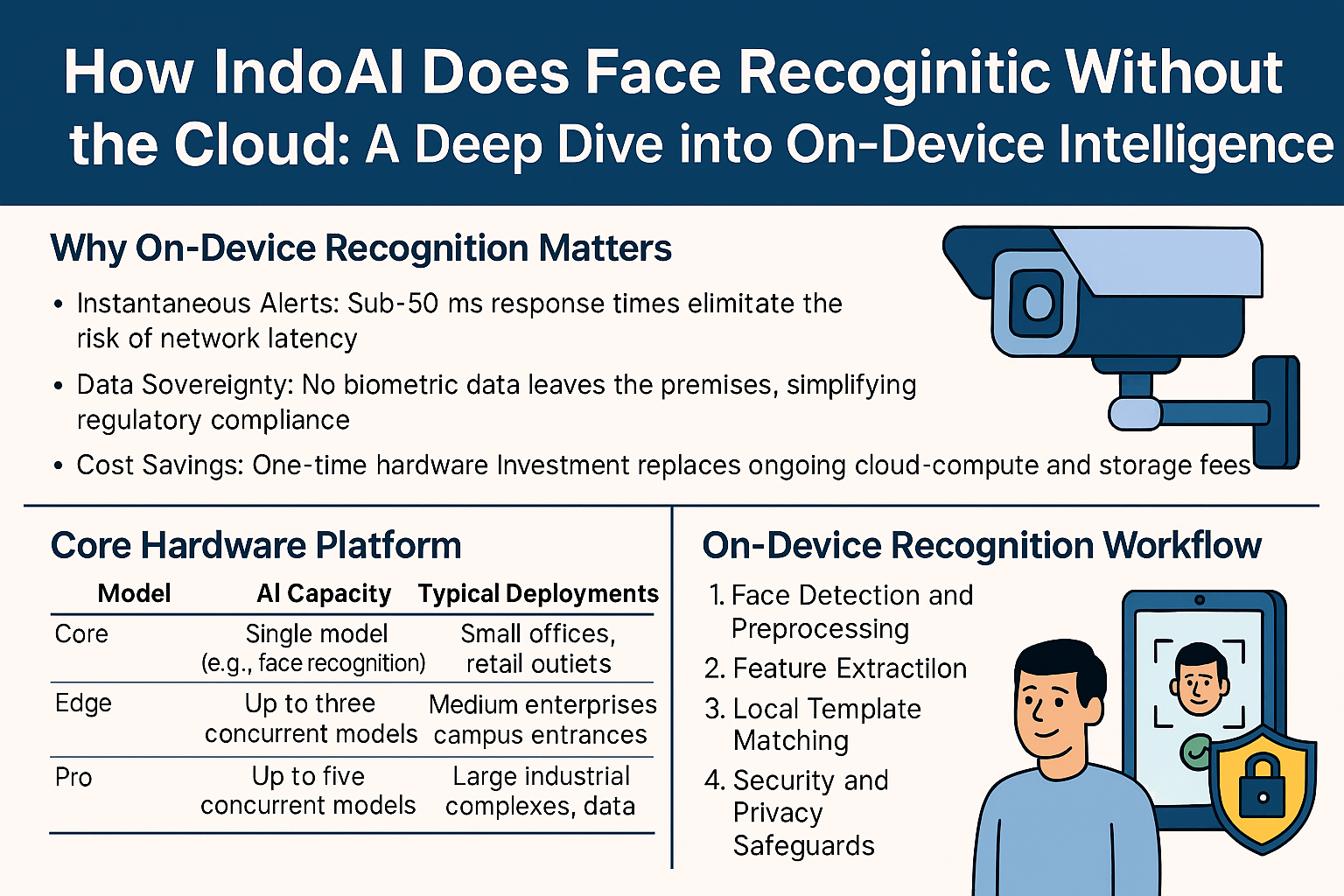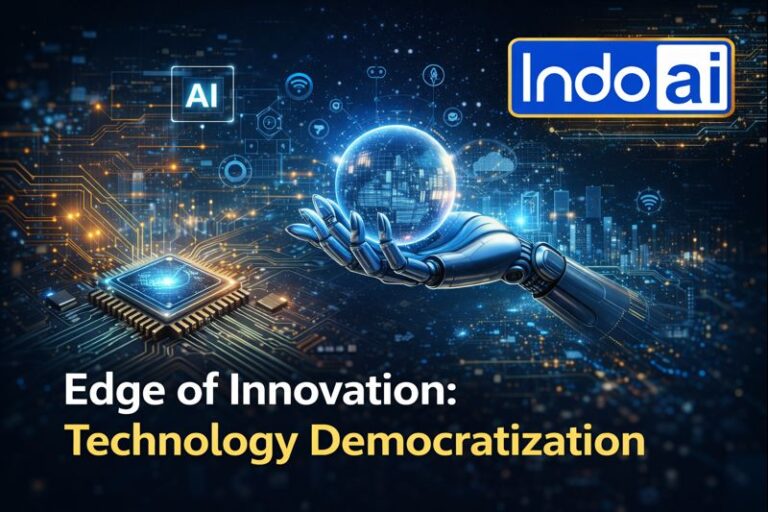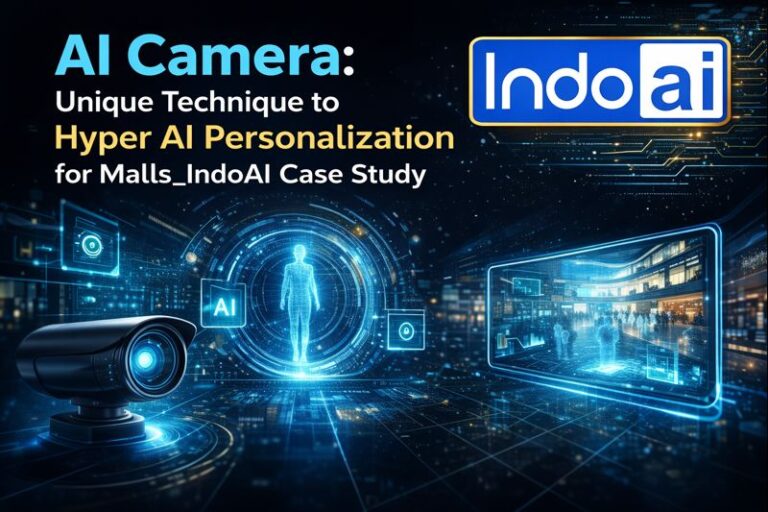
Introduction
As organizations worldwide emphasize data privacy, rapid response, and cost concerns, cloud-based face-recognition systems are being viewed more negatively. Possible network downtime, ongoing cloud costs, and stringent requirements for data sovereignty make a solid case for processing biometric data locally. IndoAI Technologies builds a solution that addresses these issues at the source by providing a complete face-recognition pipeline within its edge-AI camera.
The Limits of Cloud‑Based Face Recognition
Before looking into IndoAI’s approach, it helps to understand why many organizations seek alternatives to cloud processing:
- Latency and Reliability: Uploading video frames to the cloud introduces round-trip delays. In security use cases—such as access control or intrusion detection—every millisecond counts. Network outages or bandwidth saturation can cripple systems that operate in the cloud.
- Privacy and Compliance: Dissemination of biometric data over public networks poses regulatory issues both in India under its Personal Data Protection Act and Europe under the GDPR. Storing facial templates in third-party servers could contradict data-sovereignty requirements.
- Operational Costs: Uninterrupted video streaming eats bandwidth and involves ongoing cloud‑compute and storage fees. In large deployments, like a factory floor with hundreds of cameras, the dollars can get out of hand.
Why On‑Device Recognition Matters
Most cloud-based solutions use a model of streaming video to remote servers (often hundreds or thousands of miles away) for analysis, which can introduce delays and potentially great undo security operations. If an unauthorized individual were to enter a secured location, every millisecond counts. A transient fault in the network could allow the intruder to enter unnoticed.
Core Hardware Platform
IndoAI’s edge‑AI lineup includes three camera tiers—Core, Edge, and Pro—each optimized for different scale and performance needs:
| Model | AI Capacity | Typical Deployments |
|---|---|---|
| Core | Single model (e.g., face recognition) | Small offices, retail outlets |
| Edge | Up to three concurrent models | Medium enterprises, campus entrances |
| Pro | Up to five concurrent models | Large industrial complexes, data centers |
On‑Device Recognition Workflow
1. Face Detection and Preprocessing
A simple convolutional network iterates over each frame of a video to find faces. Prior to feeding each region with a face into the next stage, we normalize the regions by scaling, color balancing and contrasting to provide uniform inputs.
2. Feature Extraction
The system utilizes a compact embedding network (similar to MobileFaceNet) to map each face to fixed-length feature vector. The model optimizations employ quantization and pruning to minimize the inference footprint and preserve accuracy.
3. Local Template Matching
Rather than offload to the cloud, the camera keeps an encrypted database of face embeddings on device. If a new face comes up, its vector is against stored identities with cosine similarity as the measure. The threshold for matching stored identities is configurable to a balance of security and usability.
4. Alerting and Logging
As soon as a match (or unknown face) is confirmed, the camera executes predefined actions in real time; unlock doors, trigger alarms, send notifications via SMS and/or mobile apps. Each event has a time stamped and stored locally, with the option to batch sync the data back to a central dashboard.
Security and Privacy Safeguards
To protect sensitive biometric data, IndoAI implements multiple layers of security:
- Encrypted Storage: Face templates and logs use AES‑256 encryption at rest. This prevents unauthorized access even if the device is physically compromised.
- Secure Boot & Firmware Verification: Cameras validate firmware signatures at startup, blocking any tampered or unauthorized code.
- Role‑Based Access Control: Administrators assign granular permissions, ensuring only authorized personnel can manage identities or view footage.
- End‑to‑End Encryption: Metadata and event logs transmitted to external systems utilize TLS 1.3 for maximum security.
Integration and Management
Although face recognition occurs entirely on-device, IndoAI provides flexible management options:
- APIs & SDKs: RESTful endpoints and language‑specific libraries (Python, JavaScript) enable seamless integration with HR systems, access‑control platforms, or CRM tools.
- Centralized Dashboard: Organizations can choose an on‑premises server or cloud-hosted portal to aggregate logs, configure devices, and generate reports.
- Mobile Application: Supervisors receive real‑time notifications, review events, and manage user permissions directly from their smartphones.
Real‑World Use Cases
IndoAI cameras are transforming access control in manufacturing plants to be badge-less and hands free while also providing accurate shift logs. On corporate campuses, automated attendance reporting goes directly into payroll and HR systems, entirely removing the potential for human error from manual entry. Retail chains are using VIP recognition to enhance customer service while institutions of learning are securing campaus perimeter protection and visitor access – with not a single frame leaving the device!
IndoAI’s Edge‑AI Hardware Platform
IndoAI offers a family of AI cameras and compute modules designed specifically for on‑device inference:
- Camera Variants (Core, Edge, Pro): Each model features a powerful System‑on‑Module (SoM)—such as NVIDIA Jetson Nano or Google Coral—capable of running multiple deep‑learning models concurrently.
- Modular Design: Cameras support “Appization,” a container‑based framework that lets users install, update, or remove AI models (including face‑recognition) without firmware changes.
- High‑Resolution Imaging: Up to 4K sensors capture detailed facial features, improving recognition accuracy across varied lighting and distance conditions.
- Dedicated AI Accelerators: Embedded GPUs or TPUs handle convolutional‑neural‑network (CNN) inference at frame rates exceeding 20 FPS, ensuring real‑time performance.
Future Directions
IndoAI continues to innovate, with upcoming features including:
- Mask‑Tolerant Recognition: Enhanced models capable of accurately identifying partially covered faces.
- 3D Depth Sensing: Incorporating depth cameras for liveness detection and anti-spoofing.
- Federated Learning: Collaborative model improvements across devices without sharing raw data.
- Multi‑Modal Biometrics: Combining facial recognition with voice or gait analytics to bolster security.
Conclusion
IndoAI has embedded an entire face-recognition pipeline into its edge-AI cameras and eliminates the downsides of being cloud-dependent—ie, instant alerts, data sovereignty, and operational cost savings. Others (beyond IndoAI) are delivering reliable, real-time biometric authentication in various industries with their proven and reliable hardware, optimized AI models, and security and privacy maturities. In an era of device-based inference, How IndoAI Does Face Recognition Without the Cloud is a yardstick for secure, efficient, and truly scalable face-recognition.



